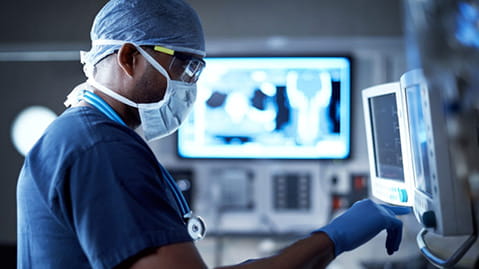The marriage between molecular biology and in silico technologies has driven medical innovation at an unprecedented rate in recent years.
Artificial intelligence, in particular, is assisting the discovery and development of treatments for complex diseases.
Equally important advances are being driven by digital communications technology, particularly in the medical devices sector. Here, algorithms are applied to mediate the communication of information between devices in or on the body and personal handheld devices or medical centres. Such devices can enable the monitoring, diagnosis and or treatment of individuals much more effectively, by measuring, computing and presenting the results for a specific patient in real time.
The reliance of this technology on these digital methods is, however, pushing issues about their patentability to the forefront of consideration. This is particularly important for computer programs, algorithms and the presentation of information, all of which are excluded from patent protection by statute "as such" (that is, without more).
Computer implemented inventions
Computer implemented inventions typically combine a computer program element with operating hardware or a system of hardware. This is a combination of subject matter excluded by statute from patent protection, as such (the computer program, the mathematical method or algorithm it uses and the presentation of the results to the user) and subject matter that's not excluded by statute from patent protection (the hardware).
How do the courts treat such mixture of excluded and non-excluded subject matter?
In England and Wales, the approach taken to whether a computer implemented invention qualifies for patent protection is set out in the joint appeal cases Aerotel and Macrossan. The judgment in this case provides a four-step test:
- Properly construe the patent claim.
- Identify the actual contribution – what has the inventor really added to human knowledge?
- Ask whether it (the contribution) falls solely within the excluded subject matter (for example, a method of doing business or computer software).
- If still necessary, ask whether the contribution is actually technical in nature.
The Aerotel approach takes the invention and removes non-novel subject matter (typically standard hardware elements), and then asks whether what is left is of a technical nature – a technical contribution or effect. Inventions containing other excluded subject matter, for example, algorithms and the presentation of information, are treated in the same way by the courts.
"Signposts" to technical contribution
The courts have said that it is difficult to formulate a more precise test and that each case must be determined by reference to its particular facts and features. However, in AT&T Knowledge Ventures' Application the Patents Court builds on Aerotel, by setting out a number of “signposts” to assist in identifying a technical contribution:
- Does the claimed technical effect have a technical effect on a process which is carried on outside the computer?
- Does the claimed technical effect operate at the level of the architecture of the computer – ie the effect is produced irrespective of the data being processed or the applications being run?
- Does the claimed technical effect result in the computer being made to operate in a new way?
- Does the program make a computer a better computer in the sense of running more efficiently and effectively as a computer?
- Is the perceived problem overcome by the claimed invention as opposed to being merely circumvented?
A positive answer to any of these questions will tend to suggest a technical contribution. It is not, however, an exhaustive list that can be regarded as providing an answer in every case.
Example cases with and without a technical contribution
The signposts were endorsed by the Court of Appeal, in HTC Europe Co Ltd v Apple Inc, albeit with a modified fourth signpost (included above). HTC Europe concerned a computer device with touch sensitive screens capable of responding to more than one touch at a time – by dividing up the screen of the device into views and configuring them as single-touch or multi-touch.
It illustrates an invention that provided a technical contribution or effect beyond the computer program and was not excluded "as such": the system software enabled the multi-touch function by changing the basic internal operation of the device, causing it to operate in a new and improved way.
Lantana also followed the signposts and came to a different conclusion. Lantana related to a method of extracting and transferring data between two computers. The method operated when both computers were linked up to the internet and one made a request to the other for a file. The local computer had a list of the documents on the other computer. The user of the local computer would send an email message to the other which automatically responded by sending a message to the local computer with the file attached.
The Patents Court and Court of Appeal agreed with the UKIPO that the contribution was excluded as a program for a computer "as such". The substance of the invention was computer software running on conventional computers connected by a conventional network. The software moved data from one computer to another using a conventional technique for carrying out that task (ie email) and the applicant was unable to identify anything which the claim could fairly be said to contribute which had a technical character.
Securing protection
In the context of computer simulations – an area that has frequent application in the medical sciences – more guidance on the criteria for determining a technical contribution is awaited from the decision of the Enlarged Board of Appeal in G1/19.
Whatever guidance G1/19 provides, computer-implemented inventions, incorporating algorithms and methods of presenting information, will continue to lie on the very edge of what may be patented in the area of digital medical devices. To sustain patent protection the claimed invention must have a technical effect and the courts will scrutinise this.
Read more
This article is part of a series on targeted treatments; links to the other articles in this series are available below.







